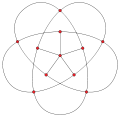
Herbert Grötzsch
Encyclopedia
Camillo Herbert Grötzsch (21 May 1902 – 15 May 1993) was a mathematician from Halle
, Germany
. Grötzsch worked in graph theory
. He was the discoverer and eponym of the Grötzsch graph
, a triangle-free graph
that requires four colors in any graph coloring
, and Grötzsch's theorem
, the result that every triangle-free planar graph
requires at most three colors. He also introduced the concept of a quasiconformal mapping
. He was one of Paul Koebe
's students.

Halle, Saxony-Anhalt
Halle is the largest city in the German state of Saxony-Anhalt. It is also called Halle an der Saale in order to distinguish it from the town of Halle in North Rhine-Westphalia...
, Germany
Germany
Germany , officially the Federal Republic of Germany , is a federal parliamentary republic in Europe. The country consists of 16 states while the capital and largest city is Berlin. Germany covers an area of 357,021 km2 and has a largely temperate seasonal climate...
. Grötzsch worked in graph theory
Graph theory
In mathematics and computer science, graph theory is the study of graphs, mathematical structures used to model pairwise relations between objects from a certain collection. A "graph" in this context refers to a collection of vertices or 'nodes' and a collection of edges that connect pairs of...
. He was the discoverer and eponym of the Grötzsch graph
Grötzsch graph
In the mathematical field of graph theory, the Grötzsch graph is a triangle-free graph with 11 vertices, 20 edges, and chromatic number 4. It is named after German mathematician Herbert Grötzsch, and its existence demonstrates that the assumption of planarity is necessary in Grötzsch's theorem ...
, a triangle-free graph
Triangle-free graph
In the mathematical area of graph theory, a triangle-free graph is an undirected graph in which no three vertices form a triangle of edges. Triangle-free graphs may be equivalently defined as graphs with clique number ≤ 2, graphs with girth ≥ 4, graphs with no induced 3-cycle, or locally...
that requires four colors in any graph coloring
Graph coloring
In graph theory, graph coloring is a special case of graph labeling; it is an assignment of labels traditionally called "colors" to elements of a graph subject to certain constraints. In its simplest form, it is a way of coloring the vertices of a graph such that no two adjacent vertices share the...
, and Grötzsch's theorem
Grötzsch's theorem
In the mathematical field of graph theory, Grötzsch's theorem is the statement that every triangle-free planar graph can be colored with only three colors...
, the result that every triangle-free planar graph
Planar graph
In graph theory, a planar graph is a graph that can be embedded in the plane, i.e., it can be drawn on the plane in such a way that its edges intersect only at their endpoints...
requires at most three colors. He also introduced the concept of a quasiconformal mapping
Quasiconformal mapping
In mathematical complex analysis, a quasiconformal mapping, introduced by and named by , is a homeomorphism between plane domains which to first order takes small circles to small ellipses of bounded eccentricity....
. He was one of Paul Koebe
Paul Koebe
Paul Koebe was a 20th-century German mathematician. His work dealt exclusively with the complex numbers, his most important results being on the uniformization of Riemann surfaces in a series of four papers in 1907–1909. He did his thesis at Berlin, where he worked under Herman Schwarz...
's students.

Publications
- Herbert Grötzsch, Über die Verzerrung bei schlichten nicht-konformen Abbildungen und über eine damit zusammenhängende Erweiterung des Picardschen Satzes, Sitzungsberichte sächs. Akad. Wiss., Math.-Phys. Klasse, vol. 80, 1928, pp. 503–507

